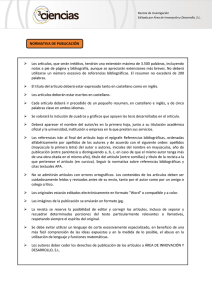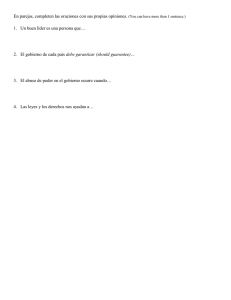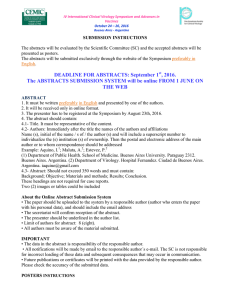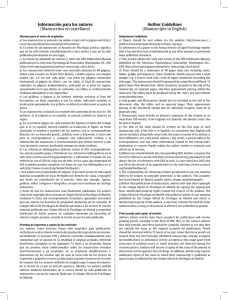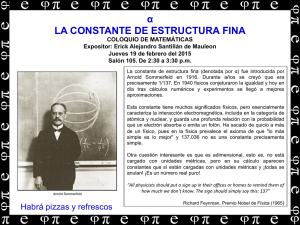NORMAS EDITORIALES Introducción El Boletín de Geología, la
Anuncio
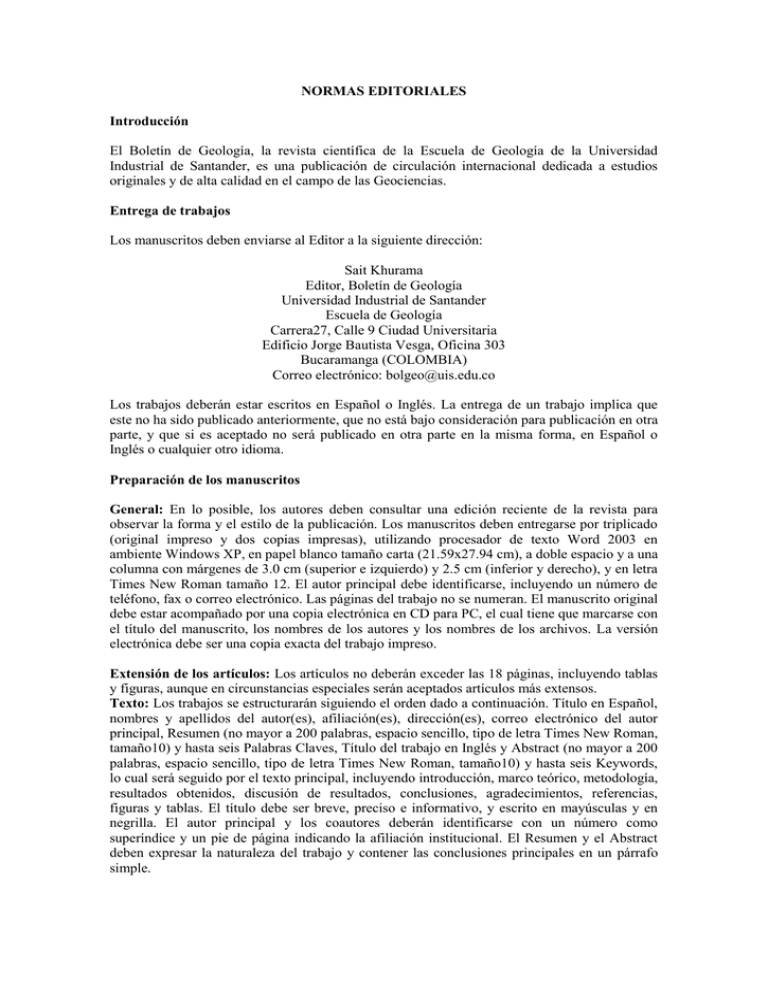
NORMAS EDITORIALES Introducción El Boletín de Geología, la revista científica de la Escuela de Geología de la Universidad Industrial de Santander, es una publicación de circulación internacional dedicada a estudios originales y de alta calidad en el campo de las Geociencias. Entrega de trabajos Los manuscritos deben enviarse al Editor a la siguiente dirección: Sait Khurama Editor, Boletín de Geología Universidad Industrial de Santander Escuela de Geología Carrera27, Calle 9 Ciudad Universitaria Edificio Jorge Bautista Vesga, Oficina 303 Bucaramanga (COLOMBIA) Correo electrónico: bolgeo@uis.edu.co Los trabajos deberán estar escritos en Español o Inglés. La entrega de un trabajo implica que este no ha sido publicado anteriormente, que no está bajo consideración para publicación en otra parte, y que si es aceptado no será publicado en otra parte en la misma forma, en Español o Inglés o cualquier otro idioma. Preparación de los manuscritos General: En lo posible, los autores deben consultar una edición reciente de la revista para observar la forma y el estilo de la publicación. Los manuscritos deben entregarse por triplicado (original impreso y dos copias impresas), utilizando procesador de texto Word 2003 en ambiente Windows XP, en papel blanco tamaño carta (21.59x27.94 cm), a doble espacio y a una columna con márgenes de 3.0 cm (superior e izquierdo) y 2.5 cm (inferior y derecho), y en letra Times New Roman tamaño 12. El autor principal debe identificarse, incluyendo un número de teléfono, fax o correo electrónico. Las páginas del trabajo no se numeran. El manuscrito original debe estar acompañado por una copia electrónica en CD para PC, el cual tiene que marcarse con el título del manuscrito, los nombres de los autores y los nombres de los archivos. La versión electrónica debe ser una copia exacta del trabajo impreso. Extensión de los artículos: Los artículos no deberán exceder las 18 páginas, incluyendo tablas y figuras, aunque en circunstancias especiales serán aceptados artículos más extensos. Texto: Los trabajos se estructurarán siguiendo el orden dado a continuación. Título en Español, nombres y apellidos del autor(es), afiliación(es), dirección(es), correo electrónico del autor principal, Resumen (no mayor a 200 palabras, espacio sencillo, tipo de letra Times New Roman, tamaño10) y hasta seis Palabras Claves, Título del trabajo en Inglés y Abstract (no mayor a 200 palabras, espacio sencillo, tipo de letra Times New Roman, tamaño10) y hasta seis Keywords, lo cual será seguido por el texto principal, incluyendo introducción, marco teórico, metodología, resultados obtenidos, discusión de resultados, conclusiones, agradecimientos, referencias, figuras y tablas. El título debe ser breve, preciso e informativo, y escrito en mayúsculas y en negrilla. El autor principal y los coautores deberán identificarse con un número como superíndice y un pie de página indicando la afiliación institucional. El Resumen y el Abstract deben expresar la naturaleza del trabajo y contener las conclusiones principales en un párrafo simple. Unidades, símbolos y abreviaturas: Se deben utilizar las unidades correspondientes al Sistema Internacional (SI). Las siglas mantendrán la correspondencia con las iniciales originales. Referencias: En el texto las referencias se citarán usando el primer apellido del autor, seguido por el año de publicación; por ejemplo, “Según Whitney (1998), la evolución tectonometamórfica...” o “…con los resultados obtenidos más tarde (Spear, 1998)”. Para dos autores use el primer apellido de los autores, separados por “y (español) o and (ingles)”, y seguidos por el año de publicación; por ejemplo, “...de acuerdo con Prigogine y Defay (2002)” o “…recientemente reportado por diferentes autores (Schairer and Yorder, Jr, 2003)”. Para tres autores use el primer apellido del primer autor, seguido por “et al.”, y por el año de publicación; por ejemplo, “Soares et al. (2001) han determinado…” o “…la homogenización por difusión de granates originalmente zonados (Tracy et al., 2004)”. Las comunicaciones verbales deben citarse en el texto, usando el primer apellido del autor (con iniciales del nombre), seguido de “comunicación verbal”, así: (Medina, L., comunicación verbal). Los manuscritos en revisión deben citarse en el texto, usando el nombre de los autores, seguido de “manuscrito en revisión”, así: (Fernández et al., manuscrito en revisión). Los manuscritos en impresión deben citarse en el texto, usando el primer apellido de los autores, seguido de “manuscrito en imprenta”, así: (Vargas y Reyes, manuscrito en imprenta). Todas las publicaciones citadas en el texto deberán ser presentadas en una lista de referencias, a continuación de los agradecimientos. Esta deberá presentarse en orden alfabético por los apellidos de los autores. Varias referencias del mismo autor deben organizarse cronológicamente y distinguirse por a, b, c,… después del año de publicación (cuando el año de publicación sea el mismo). Los nombres de las revistas deben escribirse de forma completa. Las referencias de trabajos de tesis deben incluir la institución patrocinadora y su localización, mientras que aquellas de artículos presentados (y publicados) en eventos científicos deben incluir el título del artículo, nombre completo del evento, lugar, fecha y número de páginas dentro de las Memorias. Evite la inclusión de referencias publicadas solo como Abstracts. Las referencias deben llevarse a cabo como se ilustra en los ejemplos dados a continuación. Libros: MacKenzie, W. y Adams, A. 1997. Atlas en color de rocas y minerales en lámina delgada. Masson, S.A. Barcelona, 215p. Deer, W., Howie, R., and Zussman, J. 1998. An Introduction to the Rock-Forming Minerals. Longman. New York, 528p. Capítulos de libros: Whittaker, E. 1977. Determination of atomic occupancies. In: Thermodynamics in geology (Fraser, D.G. Ed.).D. Reidel publishing Co., Dordrecht, pp. 99-113. Artículos en revistas: Skelton, A., Graham, C., and Bickle, M. 1995. Lithological and structural controls on regional 3-D fluid flow patterns during greenschist facies metamorphism of the Dalradian of the SW Scottish Highlands. Journal of Petrology, 36(4): 563-586. Publicaciones especiales no seriadas: Ordóñez, S.y García, M. 1995. Potencial geológico de mármoles en España. En: López, J. Manual de rocas ornamentales. Entorno gráfico S. L. Madrid, pp. 81-101 Trabajos publicados en memorias de eventos: García, C. 1998. Espectros infrarrojos de biotitas metamórficas. X Congreso Latinoamericano de Geología, Vol. 2., Buenos Aires, Argentina, pp. 252-256. Informes y trabajos inéditos: Se citará el autor o autores, año de la realización y ubicación de dicho trabajo. Fuentes electrónicas: Autor, inicial(es) de su nombre, año. Título del trabajo. Fecha de consulta de la información, dirección en Internet. Ejemplo: Simandi, G. et al. 1998. Kyanite, muscovite, garnet in metasediments. Consultado el 6 de marzo de 2008. http://www.empr.gov.bc.ca/mining/Geolsurv/MetallicMinerals/MineralDepositProfiles/profiles/ p02.htm Ilustraciones: Las ilustraciones (fotografías, mapas, columnas, secciones y diagramas) deben referirse con la palabra “FIGURA”, seguida del número arábigo correspondiente. Las figuras deben ser de alta resolución, presentarse en formato JPG o elaboradas en Corel Draw, y apropiadas para su reproducción. Cada ilustración debe numerarse y citarse en el orden de aparición en el texto. Las ilustraciones llevarán en la parte inferior una leyenda explicativa, a continuación de la palabra FIGURA y del número arábigo correspondiente. Las ilustraciones deben ajustarse a las márgenes de la página. Los mapas tendrán un tamaño máximo de 17 cm x 22 cm. Las figuras deben acompañar al manuscrito, pero no deben incluirse dentro del texto. Las fotografías tomadas con cámara digital deberán tener como mínimo una resolución de 1.000 x 1.000 píxeles o mínimo 300dpi. Cada figura se presentará en hoja separada indicando en el texto su sitio de inserción. Las ilustraciones se publican en blanco y negro. Los costos por la publicación a color de las ilustraciones deberán ser sufragados por el autor(es), mediante pago por adelantado a la División de Publicaciones de la Universidad Industrial de Santander. Tablas: Las tablas deben referirse con la palabra “TABLA”, seguida del número arábigo correspondiente. Las tablas deben elaborarse en Word 2003 o Excel 2003, y deben ser apropiadas para su reproducción. Cada tabla debe numerarse y citarse en el orden de aparición en el texto. Las tablas llevarán en la parte superior una leyenda apropiada, a continuación de la palabra TABLA y del número arábigo correspondiente. Las tablas deben ajustarse a las márgenes de la página. Las tablas deben acompañar al manuscrito, pero no deben incluirse dentro del texto. Cada tabla se presentará en hoja separada indicando en el texto su sitio de inserción. Los pie de página para las tablas deben presentarse en la parte inferior de la tabla y deben referirse con un superíndice en letras minúsculas. Las tablas se publican en blanco y negro. Los costos por la publicación a color de las tablas deberán ser sufragados por el autor(es), mediante pago por adelantado a la División de Publicaciones de la Universidad Industrial de Santander. Aceptación: Los trabajos recibidos serán revisados por el Comité Editorial para verificar que su contenido sea apropiado para la revista, y se ajuste a las normas editoriales. En caso que esto no ocurra, los trabajos serán devueltos al autor(es) para correcciones si es del caso. Los trabajos recibidos serán evaluados por al menos dos árbitros. Si ambos árbitros coinciden en rechazar el trabajo o, existen serios cuestionamientos al contenido del mismo, este no será aceptado para su publicación en el Boletín de Geología. Si solo uno de los árbitros lo rechaza, el Comité Editorial seleccionará un tercer árbitro y de su concepto se tomará la decisión final. Los resultados de las evaluaciones serán comunicados al autor(es). Los nombres de los árbitros permanecerán como anónimos excepto cuando ellos deseen revelar sus nombres. En cualquier caso se espera que los autores los mencionen en los Agradecimientos. Los manuscritos entregados al Boletín de Geología serán aceptados para publicación solo cuando los autores hayan revisado y corregido completamente el manuscrito siguiendo las recomendaciones de los árbitros. Políticas editoriales: La publicación de cualquier trabajo no tendrá costo alguno, si las páginas impresas están dentro del límite especificado anteriormente y no presenten figuras o tablas a color. Ninguno de los originales de los manuscritos entregados, incluyendo texto, figuras y tablas, será devuelto al autor(es) esto, para minimizar la carga de trabajo al personal editorial después que el trabajo sea aceptado para publicación. Las ideas expresadas en los artículos de esta revista son responsabilidad exclusiva de sus autores. Derechos de autor: Una vez aceptado el manuscrito para su publicación, los autores transferirán los derechos de autor al Boletín de Geología mediante el diligenciamiento del formato que les será enviado. INSTRUCTIONS TO AUTHORS Introduction The Boletín de Geología, the scientific journal of the School of Geology at Universidad Industrial de Santander, is an international publication intended for original and high quality studies in the Geosciences. Submission of Papers Manuscripts can be submitted to the Editor to the following address: Sait Khurama Editor, Boletín de Geología Universidad Industrial de Santander Escuela de Geología Carrera27, Calle 9 Ciudad Universitaria Edificio Jorge Bautista Vesga, Oficina 303 Bucaramanga (COLOMBIA) Correo electrónico: bolgeo@uis.edu.co Papers should be written in Spanish or English. Submission of a paper implies that it has not been published previously, that it is not under consideration for publication elsewhere, and that if accepted it will not be published elsewhere in the same form, in Spanish or English or in any other language. Preparation of the manuscripts General: If is possible, authors are recommended to check a recent edition of journal to review for styling. The manuscripts, which require of high quality printouts, should be presented in triplicate (printed original and two printed copies), using wordprocessor Word 2003 for Windows XP, in white letter paper (size 21.59x27.94 cm), double-spaced with upper and left margins of 3.0 cm and lower and right margins of 2.5 cm, and with a Times New Roman font and size of 12 pt. The corresponding author should be identified, including a phone/fax number and e-mail address. The original manuscript should be accompanied by an electronic version in CD for PC, which have to be marked with the manuscript title, and the authors’ and files’ names. The electronic version should be a exact copy of the printout version. Paper Length: Papers should not be up to 18 pages, including tables and figures, although in special circumstances longer papers will be considered. Text: Papers should be typed according to the following order: Title in Spanish, author’s name (es) and surname(s), affiliation(s), address(es), e-mail address of the main author, Resumen (not exceeding 200 words) and up to five keywords, Title in English and Abstract (not exceeding 200 words) and up to five keywords, which will be followed by the main text, including introduction, theoric mark, methodology, results, discussion, concluding remarks, acknowledgements, references, figures and tables. The title should be short, precise and informative, and written in capital letters. The corresponding author should be identified with an number and footnote, no other footnotes should be used. The Resumen and the Abstract should express the nature of the research work and contain the most outstanding conclusions in a single paragraph. Units, symbols and abbreviations: International System of Units (SI) should be used. Only internationally agreed abbreviations should be used. References: In the text refer to the author’s family name, followed by year of publication; for example, “According to Whitney (1998), the tectono-metamorphic evolution...” or “…with results obtained later (Spear, 1998)”. For two authors use their family names, separated by “&”, and followed by year of publication; for example, “...according to Prigogine and Defay (2002)” or “…recently reported by different authors (e.g., Schairer and Yorder, Jr, 2003)”. For three or more authors use the family name of the first author followed by “et al.” and year of publication; for example, “Soares et al. (2001) have determined…” or “…diffusive homogenization of originally zoned garnets (e.g., Tracy et al., 2004)”. Oral communications should be cited in the text, by refering to the author’s family name (with initials of the name), followed by “oral communication”: (Medina, L., oral communication). Manuscripts under review should be cited in the text, by refering to the authors’ family name, followed by “manuscript under review”: (Fernandez et al. manuscript under review). Manuscripts in print should be cited in the text, by refering to the authors’ family name, followed by “manuscript in print”: (Vargas and Reyes, manuscript in print). All publications cited in the text should be presented in a list of references following the acknowledgements. It should be arranged alphabetically by authors' family names. Several references from the same author should be organized chronologically and distinguished by a, b, c,… after year of publication (for the same year of several publications). Journal names should be spell out completely. In the case of theses, the granting institution and their location should be given. In the case of references of papers presented (and published) in scientific meetings, the title of the paper, complete name of the event, place, date and number of pages within the Memoirs should be included. Avoid the inclusion of references published only as Abstracts. The references should be typewritten as illustrated in the following examples: Books: MacKenzie, W. y Adams, A. 1997. Atlas en color de rocas y minerales en lámina delgada. Masson, S.A. Barcelona, 215p. Deer, W., Howie, R., and Zussman, J. 1998. An Introduction to the Rock-Forming Minerals. Longman. New York, 528p. Chapter in books: Whittaker, E. 1977. Determination of atomic occupancies. In: Thermo-dynamics in geology (Fraser, D.G. Ed.)., D. Reidel publishing Co., Dordrecht, pp. 99-113. Papers in Journals: Skelton, A., Graham, C., and Bickle, M.1995. Lithological and structural controls on regional 3D fluid flow patterns during greenschist facies metamorphism of the Dalradian of the SW Scottish Highlands. Journal of Petrology, 36(4): 563-586. Edited volume papers: Ordóñez, S.y García, M. 1995. Potencial geológico de mármoles en España. En: López, J. Manual de rocas ornamentales. Entorno gráfico S. L. Madrid, pp. 81-101 Conference proceedings papers: García, C. 1998. Espectros infrarrojos de biotitas metamórficas. X Congreso Latinoamericano de Geología, Vol. 2., Buenos Aires, Argentina, pp. 252-256. Unpublished papers: Author or authors, year and location of the works should be cited. Electronic sources: Author’s surname, initial’s name, year of publication. Title of paper. Date of Access . Web page. Example: Simandi, G. et al. 1998. Kyanite, muscovite, garnet in metasediments. 6th march of 2008. http://www.empr.gov.bc.ca/mining/Geolsurv/MetallicMinerals/MineralDepositProfiles/profiles/ p02.htm Illustrations: The illustrations (photographs, maps and diagrams) are all to be referred to as “FIGURE”, followed by the corresponding arabic number. All illustrations should have high-resolution, presented in JPG format or prepared in Corel Draw, and suitable for their reproduction. Each illustration should be cited in numerical order of appearance in the text. The illustrations are to have a caption in the lower part, following the word FIGURE and the corresponding arabic number. They should be fixed to the page margins. Maps must have a maximum size of 17 cm x 22 cm. Photographs that are submitted digitally should be saved at the minimum resolution 1.000*1.000 pixels at the scale of final printing. Resolution/scanning: Photographs should be imaged at a minimum of 300 dpi and saved as jpg. The figures should accompany the manuscript, but should not be included within the text. Each figure will be presented on a separate sheet, indicating where they have to be inserted into the text. Authors should avoid colors that do not properly print in black and white. The cost for publishing color illustrations should be assumed by the author(s), making an advanced payment to the Publisher of the Universidad Industrial de Santander. Tables: The tables are all to be referred to as “TABLE”, followed by the corresponding arabic number. All tables should be carried out as Word 6.0. or Excel files, and suitable for their reproduction. Each table should be cited in numerical order of appearance in the text. The tables have a caption in the upper part, following the word TABLE and the corresponding arabic number. They should be fixed to the page margins. The tables should accompany the manuscript, but should not be included within the text. Each table will be presented on a separate sheet, indicating where they have to be inserted into the text. Footnotes to tables should be typed below the table and should be referred to by superscript lowercase letters. Authors should avoid colors that do not properly print in black and white. The cost for publishing color tables should be assumed by the author(s), making an advanced payment to the Publisher of the Universidad Industrial de Santander. Acceptance: Papers will be reviewed by the Editorial Board in order to verify that they follow the instructions to the authors of the review Boletín de Geología. Papers do not follow them will be returned to the author(s) for corrections, while those do it will be evaluated for at least two referees. If both referees agree to reject the paper, this will not be accepted again for publication in the Boletín de Geología. If only one referee rejects the paper, the Editorial Board will select a third referee and from his (her) concept will take a final decision. The results of review will be communicated to the author(s) for making the corresponding modifications if is the case. Names of reviewers will remain anonymous except when they want to reveal their names. In the last case it is expected that authors will mention their names in the Acknowledgments. Papers submitted to the Boletín de Geología will be accepted for publication only when authors have fully reviewed and corrected the manuscript following the recommendations of the referees. Publishing Policy: After the acceptance of manuscripts for publication, when necessary the manuscript will be revised by the Editorial Board. No charge will be required for publication of any paper if the printed pages are within the limit specified above. None of the submitted manuscripts, including text, figures and tables, will be sent back to the author(s) to minimize the work load on the editorial staff after the paper be accepted for publication. All ideas expressed in the papers of this review are only responsability of their author(s). Copyright: Once your paper has been accepted, all authors must sign the “Transfer of Copyrigh” agreement. By this agreement the Boletin de Geología journal protects right`s authors.
